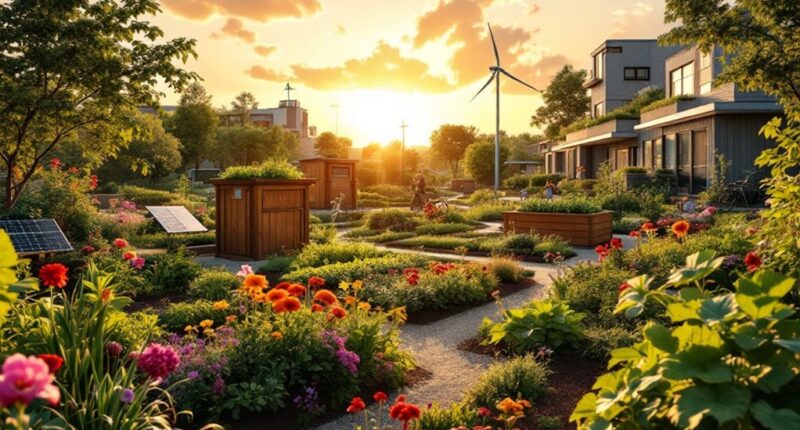Sustainable community development builds local resilience through a triple-focus approach: economic stability, environmental protection, and social well-being. Communities worldwide demonstrate this balance—Sweden’s remarkable 99% waste management, Costa Rica’s biodiversity conservation, and India’s ambitious solar program. Smart technologies and community-driven initiatives, like crowdsourced solutions and renewable energy projects, transform challenges into opportunities. Leadership, inclusive decision-making, and circular economy models create communities that thrive beyond election cycles, promising a future where prosperity doesn’t come at tomorrow’s expense.

Imagine a tapestry where economic prosperity, environmental stewardship, and social well-being are woven together so tightly that pulling one thread strengthens the others rather than unraveling the whole cloth. This is the essence of sustainable community development – an approach that meets our current needs without leaving future generations scrambling for resources like contestants in a post-apocalyptic game show.
Sustainable communities balance economic importance with environmental protection, creating places where people actually want to live, not just exist. These communities don’t happen by accident; they require participatory decision-making where everyone from the mayor to the neighborhood dog-walker has a voice. Successful projects like those in Sanjadi-ka-badia demonstrate how ecological health and economic growth can be simultaneously achieved through collaborative approaches. Think of it as community crowdsourcing, but with fewer cat videos and more actionable solutions.
Communities thrive when every voice matters—sustainability isn’t just surviving together, but designing a future worth sharing.
Around the world, the sustainable community movement is gaining impressive momentum. Sweden has mastered the art of waste management, recycling or energy-converting a staggering 99% of waste – making the average American trash can look like a monument to inefficiency. Meanwhile, tiny Costa Rica houses 5% of Earth’s biodiversity on just 0.03% of its surface, proving that size isn’t everything when it comes to ecological significance.
The path to sustainability isn’t without its potholes. Limited funding, stakeholder resistance, and the challenge of balancing immediate concerns with long-term visions create obstacles that would make even the most dedicated urban planner consider a career change. Successful implementation requires strong leadership and effective governance systems to maintain accountability and provide clear direction for sustainability initiatives. Establishing supply chain methodologies that evaluate environmental and social performance can help communities identify hidden impacts beyond their immediate boundaries.
Yet innovative approaches continue to emerge. Community-owned renewable energy projects are popping up faster than food trucks, while circular economy models are turning yesterday’s waste into tomorrow’s resources.
Smart cities are leveraging technology not just for cooler gadgets but for smarter resource management. Singapore maintains 47% green cover despite housing millions, proving that concrete jungles don’t have to sacrifice actual jungles.
India’s ambitious solar program aims for 100 GW capacity – enough energy to power countless TikTok scrolling sessions while still reducing carbon emissions.
The sustainable community approach represents more than environmental conservation – it’s about creating resilient, adaptable places where economic opportunities flourish and social connections thrive. It’s about building communities that stand the test of time, not just the next election cycle.
Frequently Asked Questions
How Can Communities Measure Progress Toward Sustainability Goals?
Communities can measure sustainability progress through a balanced approach of quantitative and qualitative methods.
They establish baseline indicators across environmental, social, and economic dimensions, then track changes using sustainability software and IoT devices.
Regular audits, community surveys, and sustainability dashboards provide transparency.
The most effective measurement systems engage community members in data collection and reporting, while integrating metrics into existing community systems for continuous monitoring and improvement.
What Funding Sources Exist for Sustainable Community Projects?
Funding sources for sustainable community projects span multiple sectors.
Government grants flow from agencies like EPA and DOE, while foundations such as the Energy Foundation and Keep America Beautiful offer targeted support.
Communities can also tap state and municipal programs through environmental agencies or planning organizations.
For innovative financing, options include crowdfunding platforms, green bonds, impact investing, and cooperative models that pool community resources—creating a diverse financial ecosystem for sustainability initiatives.
How Does Climate Change Affect Community Planning Strategies?
Climate change fundamentally reshapes community planning strategies. Planners now incorporate vulnerability assessments to identify at-risk areas and populations.
Traditional infrastructure designs are being reconsidered as extreme weather events become more frequent. Communities increasingly adopt integrated approaches that combine nature-based solutions with conventional infrastructure.
Planning processes have also evolved to prioritize equity, ensuring vulnerable populations aren’t disproportionately affected. The emphasis has shifted from growth-centered development toward resilience-building that prepares communities for uncertain climatic futures.
What Role Do Businesses Play in Sustainable Community Development?
Businesses serve as essential engines in sustainable community development through multiple channels. They generate economic activity, create jobs, and support local suppliers.
Beyond profits, their social responsibility initiatives address community challenges and promote ethical practices.
Environmentally, businesses implement green strategies that reduce ecological impacts. They also contribute to community resilience by participating in disaster recovery efforts, supporting education, and forming public-private partnerships that strengthen local infrastructure and foster innovation.
How Can Communities Overcome Resistance to Sustainability Initiatives?
Communities can overcome resistance to sustainability initiatives by educating residents about tangible benefits like cost savings and improved quality of life.
Securing buy-in from local leaders and identifying passionate champions creates momentum.
Addressing concerns through financial incentives, technical support, and phased implementation helps ease changes.
Creating diverse advisory boards guarantees all voices are heard.
Success stories from similar communities can demonstrate that sustainability isn’t just idealistic—it’s practical, economical, and ultimately inevitable for thriving neighborhoods.









